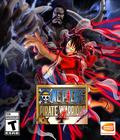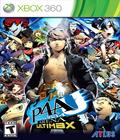Persona 4: Arena Ultimax picks up directly where the last game, Persona 4: Arena, left off. The combined heroes of Persona 3 and Persona 4 have defeated Shadow Labrys, but the source of the deadly P1 Tournament is still a mystery. In a few days, danger rears its ugly head again. The Shadow Operatives go missing, and when midnight hits the town of Inaba, it experiences something like the Dark Hour from Persona 3. The Investigation Squad is informed that the Shadow Operatives have been captured and are being held in a Tartarus-like tower. If they aren't rescued before the Dark Hour is up, the world is doomed. The Investigation Squad and the Shadow Operative's backup squad must team up to save the day.
Ultimax's plot is divided into two parts, but the only part that's initially available is the "P4" route, which focuses on the Persona 4 cast. The bulk of this involves the characters you played as in Arena, although there is a subplot featuring Rise and her combat-capable persona. Once you've finished the P4 story mode, you can take on the P3 story, which revolves around the Persona 3 cast members. It focuses on Junpei, Ken and Yukari since they're new characters. Both stories tell roughly the same plot and are told in a semi-linear fashion. You can pick which point on the timeline to hit next, but there are only two points open at any given time, and you have to do both eventually. The plot forces you to use certain characters, but several battles offer a choice of foes.
Given the short amount of time between battles, the story is cute but very shallow. Although the plot is pretty linear, the game spends a lot of time reiterating the same information. Every character has the rules explained to them by General Teddie, and then they spend time discussing the mystery of the glowing fragments that are released after each battle. The Mastermind shows up early in the game, and there aren't any twists or turns, so the story isn't very complicated. This hurts in the P3 path, which is only available after you've finished the P4 path and reiterates the same plot, only different characters. It's also unfortunate that you have to do the P4 plot first, since it has fewer new characters to play. There's a lot of fun character interaction between the P3 and P4 casts, and more importantly, Ultimax has a defined ending. There are hints of another Persona 4: Arena sequel, but this title definitely closes out (most of) the story and gives each character a nice epilogue.
The core gameplay in Ultimax has not seen any drastic changes. It is still a one-on-one fighting game based on the concept of persona usage. It's very much a 2-D fighting game akin to Street Fighter and its ilk. What sets it apart are a few minor things. Each character has a persona that's tied to two attack buttons. Persona are independent beings that you can manipulate to perform combos that aren't possible with a single character. Additionally, status effects are a big part of the game, and various attacks and abilities are capable of inflicting them. Some are generic, and some are more character-specific. Ultimax incorporates as many of the Shin Megami Tensei RPG elements as possible, giving the title a pretty distinctive feel.
Ultimax is an extremely newbie-friendly fighting game. It retains the auto-combo feature from the original title that lets you perform automated combos with repeated button presses, and it has some user-friendly button inputs. It won't have a beginner fighting like a pro, but it balances out a few of the rough spots. In addition, the new S-Hold system lets you perform special moves by holding down a button and charging it. There's also a comprehensive Lesson mode that explains every move and when and where you should use it. One feature that doesn't work too well is Auto mode, which allows you to automate your character, theoretically so even players who are terrible at fighting games can experience the story. When I turned this on, the automated fighter was unable to beat several opponents, including the final boss. Considering the power of the auto-combo, you're better off button-mashing than automating your fights.
Ultimax has a series of new available characters. New to the game are Persona 3's Junpei, Ken, Koromaru and Yukari. Junpei has a baseball-themed fighting style. As he fights his opponent, he earns hits and runs, which fill up a baseball-themed gauge next to his SP bar. The more he damages his opponent, the stronger he gets. Receiving damage gives him an out, three of which set back his power-up. Ken and Koromaru fight as a team. Ken uses a long-range poke with his spears, and Koromaru replaces most of his persona attacks. This makes his attacks harder to break but leaves Koromaru vulnerable to damage. Yukari is a typical long-range fighter with an emphasis on projectile attacks, and her special moves are designed to keep the enemy at a safe distance. Of the new characters, she is the most user-friendly.
Also joining the extended Persona 3 cast are a handful of other new characters. Rise from Persona 4 evolves her persona to a fighting form. In combat, she relies on her ability to keep the enemy away with barriers, counters and long-range attacks while chipping at the enemy's defenses. Sho Minazuki, the final boss, has two forms. One is persona-less and is a typical rushdown character, and the other has a persona and is a basic all-around character. Also coming to the game are three DLC characters: Persona 4: Golden's Marie, Adachi and Margaret. Information on the three is scant, but in addition to being DLC characters, they also have their own story modes.
One big addition to the cast is Shadow characters. Most of the characters in the game have a shadow variation that play slightly differently. They have a different auto-combo and build SP differently. Perhaps more importantly, they sacrifice some abilities in exchange for Shadow Frenzy, which is a temporary mode that gives the shadow character infinite SP for a short period of time. In essence, shadow characters are built toward offense and reward players for constant attacks. This is a neat addition to the game and gives every character two distinct play styles. (It should be noted that shadow characters are not the same as the character named Shadow Labrys.)
There's a good amount of single-player content in Ultimax. In addition to the lengthy story mode (for a fighting game), there's a series of alternate modes. Arcade mode is self-explanatory, and Challenges mode lets you take on certain tasks to improve your knowledge of a certain character. The most popular mode will probably be Golden mode, which is based on the original Persona RPG elements. Players choose a character and enter a tower where they fight opponents one by one. Defeating opponents earns you experience points so you can level up, gain stat points, and learn new skills. You can choose to bring an operator into the mode to provide passive boosts, which get stronger as you increase your Social Link level with them. It's a fun mode which adds some customization to the game. It was pretty satisfying to play as Yukari and load her up with skills that inflict bad status effects on my foes. Ultimately, Golden mode is just a diversion. There isn't much to it beyond leveling up, and it can wear out its welcome.
There's not a lot new to say about the visuals or voice acting in Ultimax. The bulk of the game has been recycled from the original Arena, and the voice acting is what you've come to expect from the Persona voice actor team. The game features a lot of new animated cut scenes and static shots for the storyline, but that's only of interest to Persona die-hards. The game looks great,the sprite work on the models is fantastic, and there's a ton of interesting details here and there. The new characters have great animations that look really distinctive. The yellow-eye shadow effect applied to Teddie's overly large mascot eyes looks significantly worse than the same effect applied to other characters.
At the end of the day, Persona 4: Arena Ultimax is icing on the Arena cake. Some changes to the core mechanics will mean a lot to players who played the heck out of the original game, but Ultimax doesn't rock the boat in any way. Ultimax is very similar to the original game, but it's bigger and better in every way.
Score: 8.0/10
More articles about Persona 4 Arena Ultimax










 Persona 4: Arena Ultimax improves on the fighting game formula with battle-altering one-hit special attacks and new characters, including Yukari Takeba and Junpei Iori from Persona 3 and a new character, Sho Minazuki.
Persona 4: Arena Ultimax improves on the fighting game formula with battle-altering one-hit special attacks and new characters, including Yukari Takeba and Junpei Iori from Persona 3 and a new character, Sho Minazuki.
































